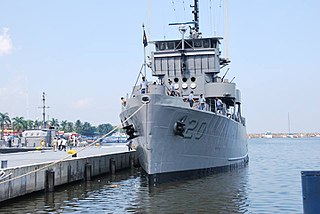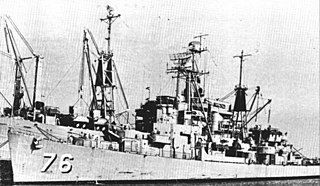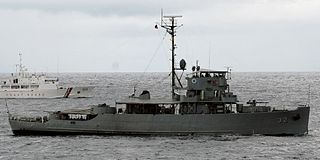USS Execute (AM-232) was an Admirable-class minesweeper built for the United States Navy during World War II. She was originally ordered and laid down as USS PCE-905, the lead ship of the PCE-905 class of patrol craft. She was reclassified as an Admirable-class minesweeper by the time of her June 1944 launch, and named Execute by the time of her November 1944 commissioning. After service in the Pacific during World War II, she was decommissioned in August 1946 and placed in reserve. While she remained in reserve, Execute was reclassified as MSF-232 in February 1955 but never reactivated. In 1962, she was sold to the Mexican Navy and renamed ARM DM-03. In 1994, she was renamed ARM General Juan N. Méndez (C51). She was stricken in July 2001, but her ultimate fate is not reported in secondary sources.

USS Shelter (AM-301) was an Admirable-class minesweeper built for the United States Navy during World War II. After service in the Pacific during World War II, Shelter was decommissioned in June 1946 and placed in reserve. In January 1964, she was transferred to South Vietnam for service in the Republic of Vietnam Navy as RVNS Chi Linh (HQ-11). She remained in South Vietnamese service until the collapse of that country in 1975. Chi Linh was one of several ships that fled from South Vietnam to the Philippines. She was then commissioned into the Philippine Navy in April 1976 as RPS Datu Tupas (PS-18), named after a chieftain of Cebu. The ship's fate is not reported in secondary sources.

USS Camp (DE-251) was an Edsall-class destroyer escort built for the U.S. Navy during World War II. She served in the Atlantic Ocean the Pacific Ocean and provided destroyer escort protection against submarine and air attack for Navy vessels and convoys.

USS Project (AM–278) was an Admirable-class minesweeper built for the United States Navy during World War II. She was decommissioned in 1947 after wartime service and transferred to the Philippine Navy in 1948 where she served under the name RPS Samar (M-33). She was stricken from the Philippine Navy in 1960; beyond that, her fate is not reported in secondary sources.

The BRP Rajah Humabon (PS-11) was a former destroyer escort of the United States Navy and a former frigate of the Philippine Navy. She was the last World War II-era destroyer escort/frigate active in her fleet, and one of the oldest active warships in the world, until 15 March 2018 when she was formally decommissioned after 75 years. She was one of three ex-USN Cannon-class destroyer escorts that served the Philippine Navy, the others being BRP Datu Sikatuna (PF-5/PS-77) and BRP Datu Kalantiaw (PS-76).

The BRP Quezon (PS-70) was one of two Rizal class ships in service with the Philippine Navy. She was formerly a USN Auk class minesweeper produced during World War II, and was later on classified as a patrol corvette protecting the vast waters of the Philippines.

The BRP Rizal (PS-74) was the lead ship and first of two Rizal class ships in service with the Philippine Navy. She was an ex-USN Auk class minesweeper that was produced during World War II, and was classified as a patrol corvette protecting the vast waters of the Philippines. Along with other ex-World War II veteran ships of the Philippine Navy, she was considered one of the oldest active fighting ships in the world, until 2020.

BRP Magat Salamat (PS-20) is one of several Miguel Malvar class of patrol corvettes in service with the Philippine Navy. She was originally built as USS Gayety (AM-239), an Admirable-class minesweeper with a similar hull to the PCE-842-class patrol craft produced during World War II. In 1962 she was transferred to South Vietnam for service in the Republic of Vietnam Navy as RVNS Chi Lang II (HQ-08). She was acquired by the Philippine Navy in April 1976 and later on commissioned as Magat Salamat. Along with other ex-World War II veteran ships of the Philippine Navy, she is considered one of the oldest active fighting ships in the world today.

BRP Datu Kalantiaw (PS-76) was the first of three ex-USN Cannon-class destroyer escorts that served with the Philippine Navy, the others being BRP Datu Sikatuna (PS-77/PF-5) and BRP Rajah Humabon (PS-78/PF-11). She was also the flagship of the Philippine Navy from 1967 to 1981.

BRP Miguel Malvar (PS-19) is the lead ship of the Miguel Malvar class of corvettes of the Philippine Navy. She was originally built as USS Brattleboro PCE(R)-852, a PCE(R)-848-class rescue patrol craft escort for the United States Navy during World War II. In 1966 she was transferred to South Vietnam for service in the Republic of Vietnam Navy as RVNS Ngọc Hồi (HQ-12). She was acquired by the Philippine Navy in April 1976 and later on commissioned as Miguel Malvar after Miguel Malvar y Carpio. The ship is in active service. Along with other World War II-era ships of the Philippine Navy, Miguel Malvar is one of the oldest active fighting ships in the world today.

BRP Sultan Kudarat (PS-22) was a Miguel Malvar-class corvette of the Philippine Navy. It was originally built as USS PCE-881, a PCE-842-class patrol craft for the United States Navy during World War II. In 1961 it was transferred to South Vietnam for service in the Republic of Vietnam Navy as RVNS Đống Đa II (HQ-07). It was acquired by the Philippine Navy on April 1976, and was commissioned later on as RPS Sultan Kudarat (PS-22). Along with other World War II-era ships of the Philippine Navy, Sultan Kudarat was considered one of the oldest active fighting ships in the world, until its retirement in July 5, 2019.
BRP Datu Marikudo (PS-23) was a Malvar-class corvette of the Philippine Navy. She was originally built as USS PCE(R)-853, a PCE(R)-848-class patrol craft for the United States Navy during World War II. She was renamed USS Amherst on 15 February 1956, namesake of both Amherst, Massachusetts and Amherst, Ohio. In February 1970, Amherst was decommissioned and transferred to South Vietnam for service in the Republic of Vietnam Navy as RVNS Vạn Kiếp II (HQ-14). She remained in South Vietnamese service until the collapse of that country in 1975. Vạn Kiếp II was one of several ships that fled from South Vietnam to the Philippines. She was then commissioned into the Philippine Navy on 5 April 1976 and named in honor of Datu Marikudo. Along with other World War II-era ships of the Philippine Navy, Datu Marikudo was considered one of the oldest active fighting ships in the world until her decommissioning.

BRP Cebu (PS-28) was a Miguel Malvar-class corvette of the Philippine Navy. She was originally built as USS PCE-881, a PCE-842-class patrol craft for the United States Navy during World War II and patrolled the Alaskan coast during that war. She was decommissioned from the U.S. Navy and transferred to the Philippine Navy in July 1948 and renamed RPS Cebu (E-28) after the Philippine province of the same name. The ship was decommissioned on 1 October 2019. Along with other World War II-era ships of the Philippine Navy, Cebu was considered one of the world's oldest fighting ships during her active service.

BRP Negros Occidental (PS-29) was a Miguel Malvar-class corvette of the Philippine Navy. She was originally built as USS PCE-884, a PCE-842-class patrol craft for the United States Navy during World War II. She was decommissioned from the U.S. Navy and transferred to the Philippine Navy in July 1948 and renamed Negros Occidental after the Philippine province of the same name. Along with other World War II-era ships of the Philippine Navy, Negros Occidental was considered one of the oldest active fighting ships in the world until its decommissioning.

BRP Pangasinan (PS-31) was a Miguel Malvar-class corvette of the Philippine Navy. She was originally built as USS PCE-891, a PCE-842-class patrol craft for the United States Navy during World War II. She was decommissioned from the U.S. Navy and transferred to the Philippine Navy in July 1948 and renamed RPS Pangasinan (E-31).

BRP Iloilo (PS-32) was a Miguel Malvar-class corvette of the Philippine Navy. She was originally built as USS PCE-897, a PCE-842-class patrol craft for the United States Navy during World War II. She was decommissioned from the U.S. Navy and transferred to the Philippine Navy in July 1948 and renamed RPS Iloilo (E-32) after the Philippine province of the same name. Along with other World War II-era ships of the Philippine Navy, Iloilo was considered one of the oldest active fighting ships in the world, being in continuous service for over seven decades.

The Malvar class is a ship class of patrol corvettes of the Philippine Navy and are currently its oldest class of corvettes. These ships were formerly used by the US Navy as Admirable-class minesweepers, and PCE-842-class and PCE(R)-848 class patrol craft, which were both based on the Admirable-class hull. In the Philippine Navy, the vessels have undergone upgrades and modifications, and have been re-categorized as corvettes. One ship, the ex-USN USS Quest was supposedly a member of this class but was converted into a non-combatant Presidential Yacht by the Philippine Navy in 1948 as RPS Pag-asa (APO-21)

BRP Rajah Lakandula (PF-4) was a frigate of the Philippine Navy, and was its only ex-USN Edsall-class destroyer escort. She was also the flagship of the Philippine Navy from 1981 to 1988.
The second I-53 was the second of three Type C cruiser submarines of the C3 sub-class built for the Imperial Japanese Navy. Commissioned in February 1944, she operated primarily as a kaiten manned suicide attack torpedo carrier during the final year of World War II and sank the destroyer escort USS Underhill (DE-682). Surrendered at the end of the war, she was scuttled by the United States Navy in 1946.














